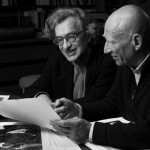Former British television director Joanna Hogg was 48 when she made her first feature film in 2008. Unrelated was a fascinating study of a fragile, childless woman who joins a friend’s family on holiday in Tuscany. As she fantasises about her neighbour’s teenage, snippets of her long distance calls to her husband signal a crumbling marriage. An estranged husband at the end of a phone line reappears in Hogg’s second film, Archipelago, when another middle-class family rent a holiday house in the Isles of Scilly In Exhibition, Hogg’s first film set in a city, the husband, who works from home, is always around, albeit often at the end of an in-house intercom.
Exhibition, with its long, slow takes from a mostly stationary camera, exhibits the life of an ordinary, if childless, marriage between two middle-aged artists and their architect’s house of 18 years. The lack of dramatic narrative, the often bland, semi-improvised dialogue from non-professional actors and the uncomfortably explicit love making are off-set, to some degree, by the couple’s interaction with the outside world and their relationship with the late architect James Melvin’s 1969 house.
Approaching fifty, H, played by real-life artist and first time actor Liam Gillick, is a successful artist sharing a stylist house in West London with his wife, D (Viv Albertine, of the former punk band, The Slits), a performance artist. When we first meet the couple they appear to be arguing about D’s reluctance to involve H with her art. ‘You should use me,’ H encourages her, ‘I’m on you side.’ But H objects. ‘You’ll say it’s silly…You’ll just put me down.’ But, before long, H is chasing a giggling D up the spiral staircase to their bedroom where they read to one another in bed. However, as in any marriage, the sex is not, as we see only too clearly, always mutually welcome or particularly explosive.
The big issue in their lives now is the sale of their home of 18 years. D confesses that she ‘still loves the place,’ while D rationalises, ‘We’ve been here so long. There are no children; nothing stopping us from doing what we want.’ We never learn what it is that they want.
Children not only have no place in their lives but D seems particularly intolerant of them, collapsing on purpose to exit a dinner party at the home of child-centric friends. Significantly, the female neighbour (Mary Roscoe, the friend from Unrelated) is also critical of their house, and not only because it is not child-friendly.
When an estate agent (a slick Tom Hiddleston, co-star of Hogg’s previous films) stops by, they discuss how to spot a developer disguised as a buyer or someone eager to demolish the house. The couple’s fears are well founded as the film’s noteworthy (and quite conspicuous) sound design includes the constant din of construction and we witness a humourous run-in with a builder who blocks their discreet car park with his car. Oddly, since the house has not been altered since it was built, there is no discussion of listing it. That might lower the price, but increase the likelihood of its preservation.
There are too few films about childless couples in a realistically portrayed relationship and it is interesting, up to a point, to observe the ups and downs of a largely successful marriage. Unfortunately, as presented in the film, the husband and wife are not that interesting, and D is not particularly sympathetic. Being artists does not make their lives entertaining. It might help if we knew more about their art, but from what we see of D’s exhibitionist performance art – at one point, she strips in front of her office window and binds herself with coloured tape –, it is rather self-indulgent and gimmicky.
There are also too few films about our relationships with our houses. In most films where the house is a key character, it is haunted. But for all cinematographer Ed Rutherford’s talent, we never actually understand the house. Arguably the best shot is taken from the street looking onto part of the lovely façade, with its alternating horizontal bands of glass windows and red brick, its recessed doorway and thin entry pillars. We see parts of the rooms, sliding partition walls and many shots of the spiral staircase, but do not have a sense of how it all fits together, or even how many floors there are (there is a lift, which is clearly for transporting furniture).
Joyce Glasser – MT film reviewer




